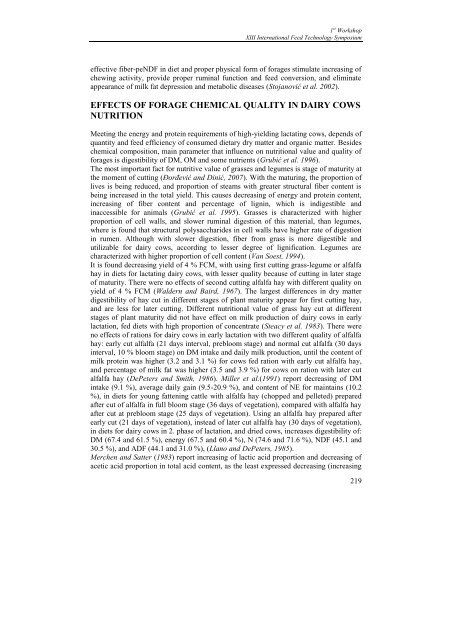Effects of dietary n-3 polyunsaturated fatty acids and ... - FINS
Effects of dietary n-3 polyunsaturated fatty acids and ... - FINS
Effects of dietary n-3 polyunsaturated fatty acids and ... - FINS
Create successful ePaper yourself
Turn your PDF publications into a flip-book with our unique Google optimized e-Paper software.
1 st WorkshopXIII International Feed Technology Symposiumeffective fiber-peNDF in diet <strong>and</strong> proper physical form <strong>of</strong> forages stimulate increasing <strong>of</strong>chewing activity, provide proper ruminal function <strong>and</strong> feed conversion, <strong>and</strong> eliminateappearance <strong>of</strong> milk fat depression <strong>and</strong> metabolic diseases (Stojanović et al. 2002).EFFECTS OF FORAGE CHEMICAL QUALITY IN DAIRY COWSNUTRITIONMeeting the energy <strong>and</strong> protein requirements <strong>of</strong> high-yielding lactating cows, depends <strong>of</strong>quantity <strong>and</strong> feed efficiency <strong>of</strong> consumed <strong>dietary</strong> dry matter <strong>and</strong> organic matter. Besideschemical composition, main parameter that influence on nutritional value <strong>and</strong> quality <strong>of</strong>forages is digestibility <strong>of</strong> DM, OM <strong>and</strong> some nutrients (Grubić et al. 1996).The most important fact for nutritive value <strong>of</strong> grasses <strong>and</strong> legumes is stage <strong>of</strong> maturity atthe moment <strong>of</strong> cutting (Đorđević <strong>and</strong> Dinić, 2007). With the maturing, the proportion <strong>of</strong>lives is being reduced, <strong>and</strong> proportion <strong>of</strong> steams with greater structural fiber content isbeing increased in the total yield. This causes decreasing <strong>of</strong> energy <strong>and</strong> protein content,increasing <strong>of</strong> fiber content <strong>and</strong> percentage <strong>of</strong> lignin, which is indigestible <strong>and</strong>inaccessible for animals (Grubić et al. 1995). Grasses is characterized with higherproportion <strong>of</strong> cell walls, <strong>and</strong> slower ruminal digestion <strong>of</strong> this material, than legumes,where is found that structural polysaccharides in cell walls have higher rate <strong>of</strong> digestionin rumen. Although with slower digestion, fiber from grass is more digestible <strong>and</strong>utilizable for dairy cows, according to lesser degree <strong>of</strong> lignification. Legumes arecharacterized with higher proportion <strong>of</strong> cell content (Van Soest, 1994).It is found decreasing yield <strong>of</strong> 4 % FCM, with using first cutting grass-legume or alfalfahay in diets for lactating dairy cows, with lesser quality because <strong>of</strong> cutting in later stage<strong>of</strong> maturity. There were no effects <strong>of</strong> second cutting alfalfa hay with different quality onyield <strong>of</strong> 4 % FCM (Waldern <strong>and</strong> Baird, 1967). The largest differences in dry matterdigestibility <strong>of</strong> hay cut in different stages <strong>of</strong> plant maturity appear for first cutting hay,<strong>and</strong> are less for later cutting. Different nutritional value <strong>of</strong> grass hay cut at differentstages <strong>of</strong> plant maturity did not have effect on milk production <strong>of</strong> dairy cows in earlylactation, fed diets with high proportion <strong>of</strong> concentrate (Steacy et al. 1983). There wereno effects <strong>of</strong> rations for dairy cows in early lactation with two different quality <strong>of</strong> alfalfahay: early cut alfalfa (21 days interval, prebloom stage) <strong>and</strong> normal cut alfalfa (30 daysinterval, 10 % bloom stage) on DM intake <strong>and</strong> daily milk production, until the content <strong>of</strong>milk protein was higher (3.2 <strong>and</strong> 3.1 %) for cows fed ration with early cut alfalfa hay,<strong>and</strong> percentage <strong>of</strong> milk fat was higher (3.5 <strong>and</strong> 3.9 %) for cows on ration with later cutalfalfa hay (DePeters <strong>and</strong> Smith, 1986). Miller et al.(1991) report decreasing <strong>of</strong> DMintake (9.1 %), average daily gain (9.5-20.9 %), <strong>and</strong> content <strong>of</strong> NE for maintains (10.2%), in diets for young fattening cattle with alfalfa hay (chopped <strong>and</strong> pelleted) preparedafter cut <strong>of</strong> alfalfa in full bloom stage (36 days <strong>of</strong> vegetation), compared with alfalfa hayafter cut at prebloom stage (25 days <strong>of</strong> vegetation). Using an alfalfa hay prepared afterearly cut (21 days <strong>of</strong> vegetation), instead <strong>of</strong> later cut alfalfa hay (30 days <strong>of</strong> vegetation),in diets for dairy cows in 2. phase <strong>of</strong> lactation, <strong>and</strong> dried cows, increases digestibility <strong>of</strong>:DM (67.4 <strong>and</strong> 61.5 %), energy (67.5 <strong>and</strong> 60.4 %), N (74.6 <strong>and</strong> 71.6 %), NDF (45.1 <strong>and</strong>30.5 %), <strong>and</strong> ADF (44.1 <strong>and</strong> 31.0 %), (Llano <strong>and</strong> DePeters, 1985).Merchen <strong>and</strong> Satter (1983) report increasing <strong>of</strong> lactic acid proportion <strong>and</strong> decreasing <strong>of</strong>acetic acid proportion in total acid content, as the least expressed decreasing (increasing219
















